Introduction
Globally, onboarding has evolved into a mature HR practice.
Successful strategic onboarding is especially important given the increasing pace of change and mobility.
Research has shown, time and time again, that onboarding has the power to influence whether new employees decide to stick with or leave an organization.
So, what is the business case for onboarding software and why does it matter?
Most organizations are AWARE they don’t execute onboarding well.
What's hard is convincing your boss and team onboarding software is a valuable investment for the company, and not just a marginal expense.
The key is showing you have thought it through.
If you're going to make a persuasive argument for employee onboarding software, you'll need to build a strong business case.
In this post, I'll show you how to secure the investment you need.
Let's Review The Problem
The first step in any business case is to establish the problem you're solving.
When it comes to employee onboarding, here are the main problems:
80% of new employees decide whether or not to stay with their new organization within the first few months, yet most organizations are aware they don’t execute onboarding well.
In fact, when Gallup1 asked employees about onboarding, 88% indicated that they didn’t think their organization was good at onboarding.
And those in charge agree with 76% of HR leaders reporting that they believe they are ineffectively onboarding their new employees.
The three top reasons managers gave for neglecting onboarding are:
- 57% noted not having enough time
- 55% noted the absence of tools to measure its effectiveness, and
- 39% reported the lack of digital onboarding technology to automate the process was challenging
There’s a strong correlation between the approach a company adopts to its onboarding and the results achieved by employees and businesses.
We acknowledge that the more maturity a company has around onboarding, the greater chance of it investing in sound strategic onboarding practices.
Why It's Worth A Strong Business Case
You might be surprised to know that building a business case for onboarding software is actually not that difficult.
The problem is most people try to buy onboarding software without one.
They think they can just wing it, or they don't know how to go about building a business case.
If you want to be taken seriously, you need to put in the effort and show you've done your homework.
Luckily I've done a lot of that for you.
How well YOU understand and support the plan will determine how your team and leadership communicate it to the rest of the organization and follow it for new hires.
Make the business case for employee onboarding software with these 5 talking points that drive home the business value.
How To Introduce Your Business Case
Acknowledging the role that ‘engagement’ plays is also a key stepping-stone to understanding the business case of onboarding.
It’s a popular buzzword in the world of brand marketing and is a word commonly used to benchmark our relationship to the world around us.
So too, its significance should not be underestimated in the context of the workplace.
Consider the following:
1) The importance of engagement in relation to providing employees with a sense of purpose and
2) Why purpose is critical to driving healthy engagement levels.
Let’s put it another way.
To be truly productive in our work, we have to be engaged.
To be engaged we have to have a purpose.
The challenge for both is resources.
Without appropriate resources managers are forced to be task-focused rather than purpose-driven which essentially sabotages engagement.
Once disengaged, productivity suffers. It’s a vicious cycle.
As the below diagram shows – culture, connection, clarification, and the WOW factor are major contributors to employee engagement levels.
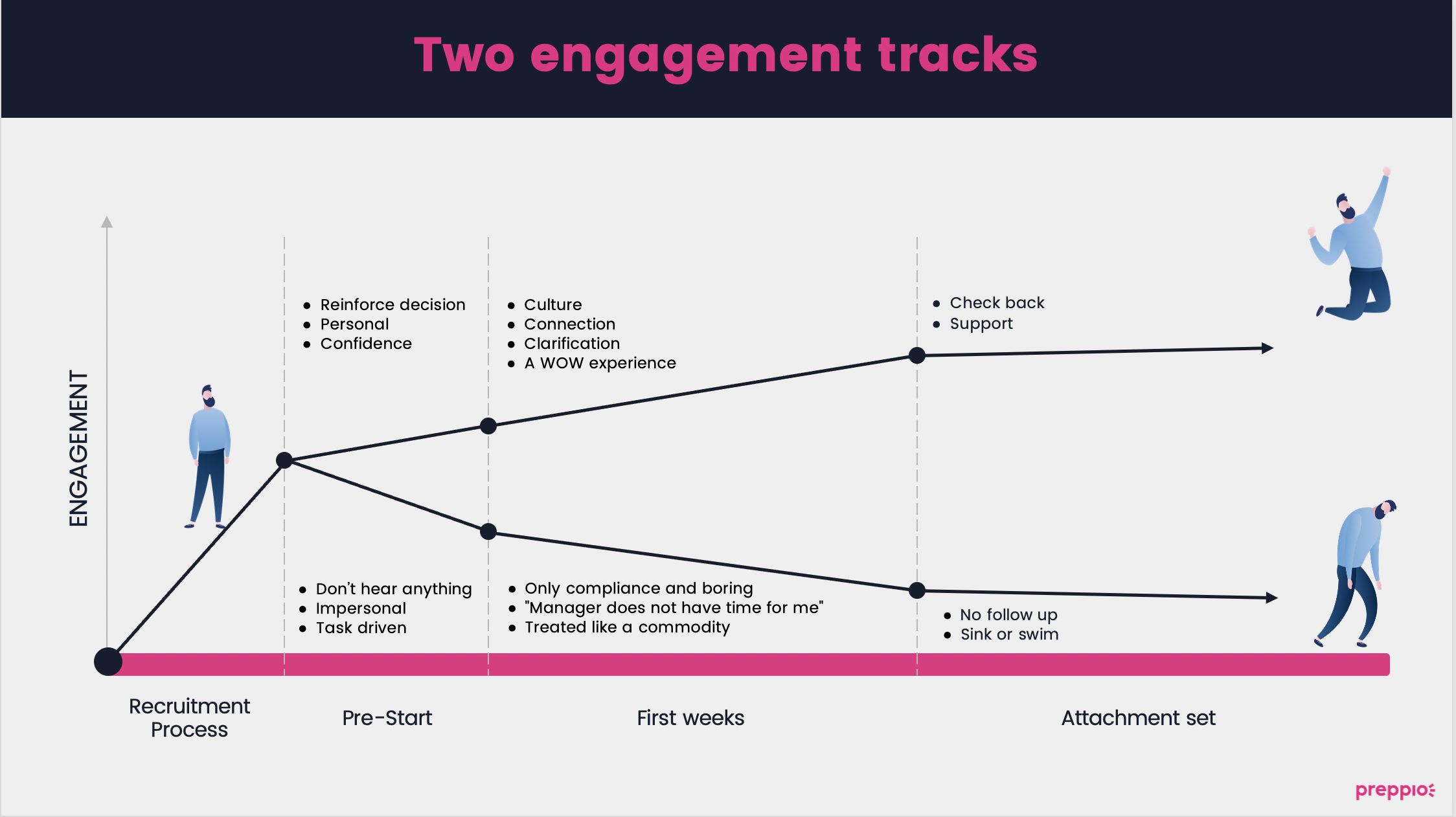
People generally have no problem doing mundane and repetitive tasks as long as it leads to other intrinsic rewards.
These rewards could include connecting with customers and colleagues, making the world a better place, feelings of accomplishment, seeing their part in something bigger, or perhaps even career advancement in the long run.
Whatever the reward, a good onboarding process recognizes these factors and helps employees understand why they are doing, what they are doing.
How To Get Leadership To See This Your Way
As part of our research, we spoke to a CEO of a large airline who noted that the best investment he made in the early days of joining the organization was getting to know the business.
It’s a normal and valid concern to be worried about a leadership change, this is why listening to people and creating reports is key for new CEOs and leaders to be able to make the changes they want.
The higher you are in an organization the more time and effort is required for that individual to get to know the business and its people.
The question is — shouldn’t the same apply to the rest of us?
Under the middle tier of management down to the ranks of junior employees, and especially frontline customer-facing employees, we consistently see examples of onboarding executed at its worst.
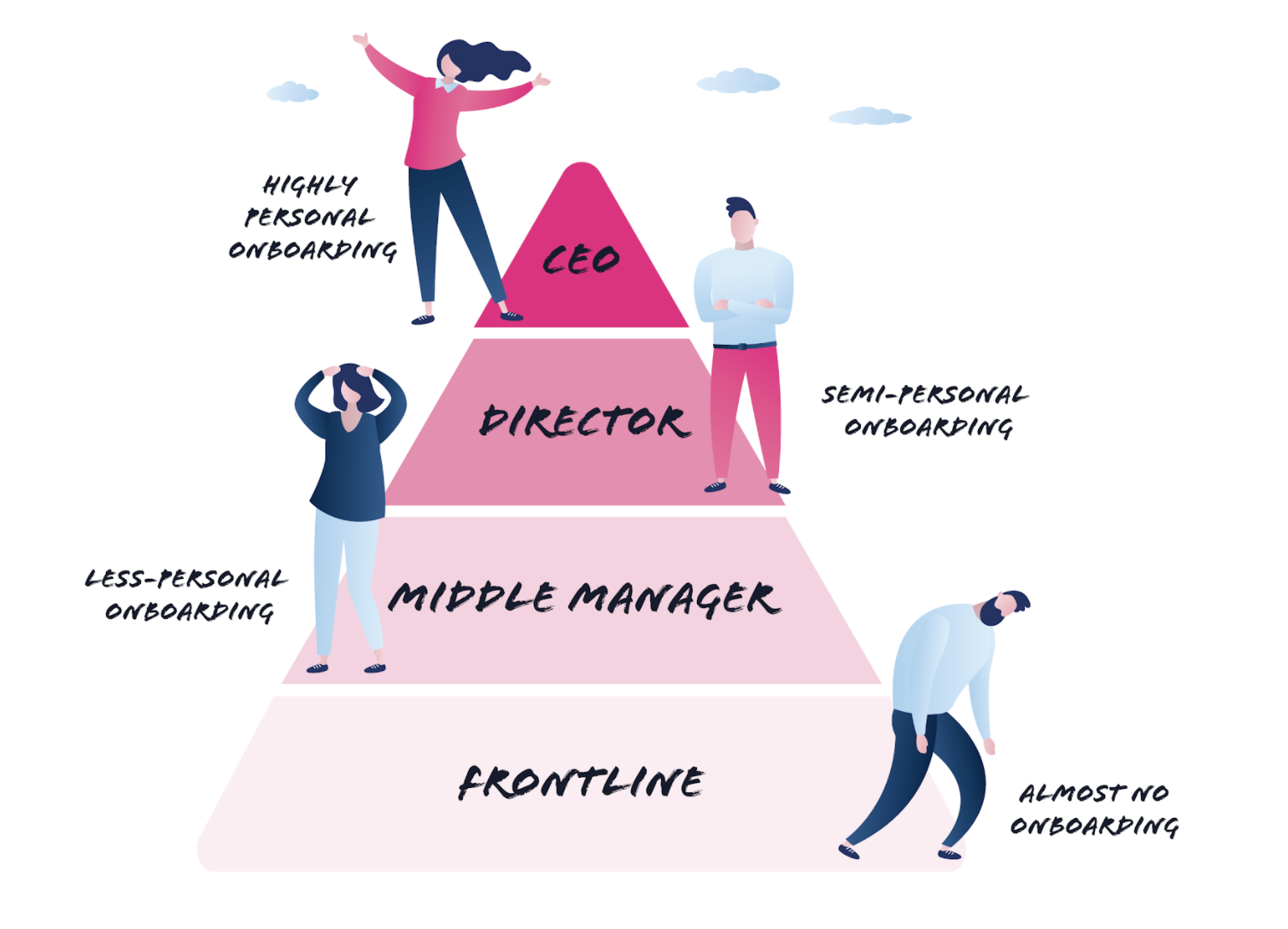
So have a think about this.
What would happen to the frontline worker if they received the CEO treatment during onboarding?
Do you think this would increase the chances of them staying with your company for longer?
With a dose of CEO treatment, would a frontline worker be more likely to become a manager and a highly engaged fan of the business?

We know it is impossible to give new hires the CEO treatment.
This analogy is simply used to drive your understanding of the CEO treatment idea.
Exceeding new hire expectations and ensuring that employees feel valued should be factored into the design of your onboarding program.
By doing so, employees’ success rates will be maximized.
By continuously asking how these success rates relate to business success you will build the business case to introduce strategic onboarding.
5 Strong Arguments To Get Your Business Case Through
These 5 steps will show you how to:
1. Articulate the business value of employee onboarding software,
2. Demonstrate a clear return on investment,
3. Build alignment with company objectives,
4. Address common objections, and
5. Get buy-in from decision makers.
By the end of this post, you'll be able to build a business case that will make it easy to get the green light for employee onboarding software.
Let's get started.
1. Employee onboarding strengthens employee engagement and retention
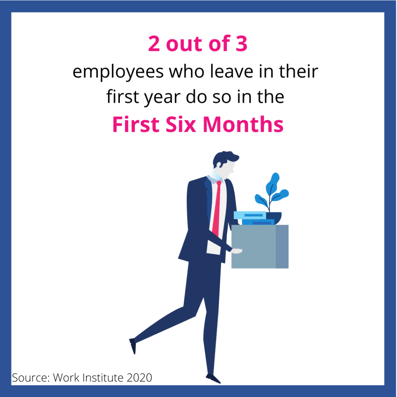
Not only are managers evaluated on employee turnover rates, but the entire workplace is impacted when employees quit at a rate higher than the industry average.
Recruiting costs increase, customer service suffers, colleagues are burdened with more work in the form of unplanned terminations, and management feels the strain of it all.
What follows is a breakdown in company culture evidenced by poor workplace morale, increased absenteeism, and decreased engagement among employees.
Employee retention and engagement go hand in hand. Despite this widespread awareness, employee engagement continues to suffer.
Research has shown, time and time again, that onboarding has the power to influence whether new employees decide to remain with or leave an organization.
Here are just a few results from surveys on the topic of turnover, engagement, and onboarding:
- When Gallup asked employees about onboarding, 88% indicated that they did not think their organization was good at onboarding, and only 12% of employees agree strongly that their organization does a great job of onboarding new people.
- Findings from another study published by the Society for HR Management showed that 86% of new employees decide whether to stay with their new organization within the first few months.
- An article in Harvard Business Review 87% of employees worldwide are disengaged
A good onboarding plan starts in the pre-boarding phase to initiate your new hires into the company culture.
They feel like a part of the time on their very first day on the job.
The onboarding process continues to instill a fabulous employee experience over their first weeks and months.
The result is increased engagement and reduced turnover.
2. Shorten the time to maximum performance for new hires
Organizations recoup the highest onboarding return on investment in the area of time-to-productivity or maximum performance.
This is the time it takes an employee to deliver optimal value to the organization.
We have found that a well-designed science-based onboarding program with supporting tools reduces time-to-productivity for new employees.
Organizations with a standardized onboarding process experience 50% greater new-hire productivity reducing the time to add real value to the company or organization versus those companies whose process is unstructured.
Like any other investment, the cost of recruiting and onboarding is expected to be recouped by a return of value to the organization.
Called the “return zone” in the diagram below, the return begins before the new hire even starts their first day on the job.
That is, with a good onboarding plan.
How can that be?
For one, the connection to the team is being developed which strengthens company culture.
Secondly, a good onboarding program creates employer branding value that attracts top talent. Read on in the next talking point for more details.
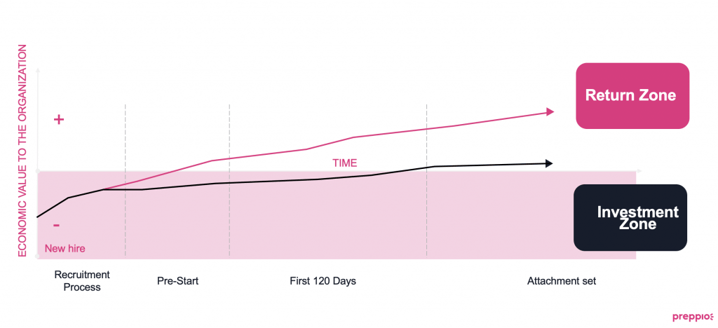
3. Improve employer branding to attract top talent
Brands create an image and public perception using language that is strategically curated for the brand and which upholds the brand’s tone of voice and personality.
Image and reputation make up the two major components of an employer brand.
This conveys the employer’s Unique Value Proposition, or UVP, and is used for marketing and job postings for all channels.
Potential candidates are influenced by social media conversations, review sites, negative word of mouth, and information from personnel connections.
These all affect the likelihood of applying to your company and accepting your job offer.
One source puts research via personal connections at a massive 46%.
Popular websites like Glassdoor, where employees rate their employers, are commonly used by employees to see if they want to apply or choose a job.
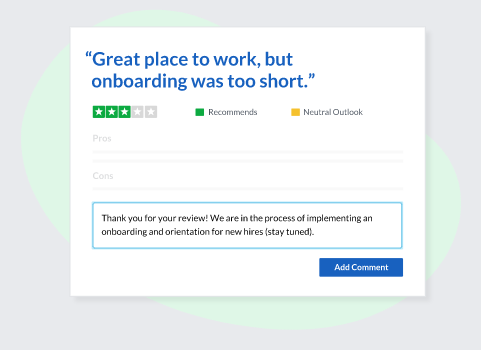 Source: https://www.glassdoor.com/employers/solutions/reviews/
Source: https://www.glassdoor.com/employers/solutions/reviews/
Bad onboarding is a common theme when it comes to poor employee reviews. Investing in the employee experience in the onboarding phase is critical for employer branding.
Get a free new hire onboarding cost and business case “calculator” to learn how much you can save!
Do you want to know the cost of onboarding a new hire to your company?
- The average cost of onboarding a new hire is 30% to 70% of their annual salary
- Recruiting and training are major costs, but time to productivity has the highest overall cost
- Companies can save up thousands of dollars per new hire hired by maximizing the onboarding success
4. Stronger, happier, and inclusive workplace culture
Onboarding is one of the key ways through which organizational culture is formed, maintained, and changed.
It starts the moment that a job offer is signed in the pre-boarding phase.
The onboarding process should be designed to help the new hire determine if they are aligned with the company culture before their very first day on the job.
A pre-boarding message about the history of the company, assignment to a buddy, and information about resources are just a few ways that the pre-boarding process can help set the right course for your new hires.
Onboarding tasks like getting new hires to post in social networks and chat tools like Slack, Workplace from Facebook, Microsoft Teams help coworkers connect and share about themselves for a heightened sense of inclusion and familiarity.
As shown below, culture is at the apex of mature onboarding and optimal employee engagement.
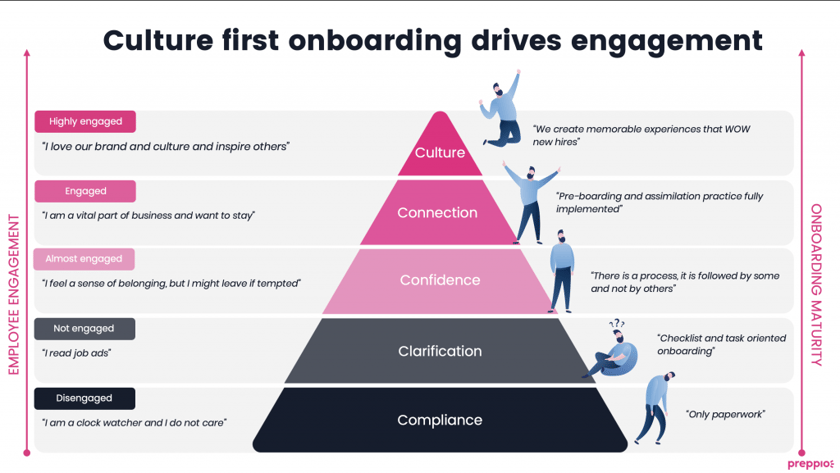
5. Relieve the strain on managers and avoid burnout
Welcoming new employees is a mixed blessing for managers.
On the one hand, they are relieved and hopeful for the value that a new hire can bring to a company.
On the other hand, it can feel like a burden in the early weeks and months of onboarding.
Indeed, a bad onboarding structure can increase the burden associated with new hires and therefore represent a strain on company resources and most importantly, the time of key onboarding stakeholders: managers, buddies, IT, and HR.
The right onboarding plan implemented by the right onboarding software will automate most of the tedious tasks that weigh down managers.
As a result, they are able to focus on their job purpose and connect with their colleagues and direct reports.
How To Close The Deal — This Is About Brand Building
A brand is a promise.
Part of this promise is the delivery of service and quality standards that meet or exceed customer expectations.
This in turn is carefully managed over time to build customer loyalty and positive brand perceptions.
All great brands strive to exceed customer expectations. So, what happens when a new hire who has had bad onboarding, is customer-facing?

Due to the link between the customer experience and employee experience, great onboarding is the solution.
Our goal is for organizations to adopt an “exceeding expectation” mindset for their brands by integrating this way of thinking early on in their onboarding program.
It’s also worth noting that the lifetime value of each hire goes beyond the duration of that individual’s employment with you.
Consider the thousands of employees that come and go after only a short time.
It’s likely that they will tell their friends and family about your business, and that conversations about your organization and your brand will be both positive and negative.
Optimizing these experiences so that each new hire talks positively about your company no matter how long they stay, is key to creating good employer branding.
When it comes to front-line onboarding, one of the best-in-class companies is Pal’s Sudden Service. CEO Thomas Crosby once said:
“We realized that we are in the education business, just like any school or university.”
This mindset has led to designing and implementing an onboarding process that results in highly engaged employees who stay.
At the Assistant Manager level, turnover is 1.4%.
At the top end, Pal has lost just seven general managers in 33 years. Meanwhile on the front lines, turnover is lower than the average rate in the industry sitting at 32%. 2
It is easier to convince the organization to invest more in the people you are hiring!
How To Build Your Actual Business Case For Employee Onboarding Software
By this point, you are prepared to discuss the benefits of a strategic onboarding plan.
You have discovered any concerns your team may have about it and have explained the role of onboarding software.
The last piece of the puzzle is the solution that will help implement and maintain your onboarding plan.
If your onboarding plan is the map, and your team is on the train, then the onboarding software is the engine that moves it forward.
Depending on the size of your workforce, onboarding software can do the work of one full-time HR assistant.
Without software it is a time-consuming job to create individual emails, messages, reminders, follow-up, measuring, data storing, reporting, and more.
All of this can be completed with onboarding software to help save your management team time and strain associated with a manual onboarding plan.
Read this blog post from Preppio to learn how employee onboarding software drives onboarding success. Download the free PDF worksheet at the end of the article to help you and your team evaluate onboarding software solutions.
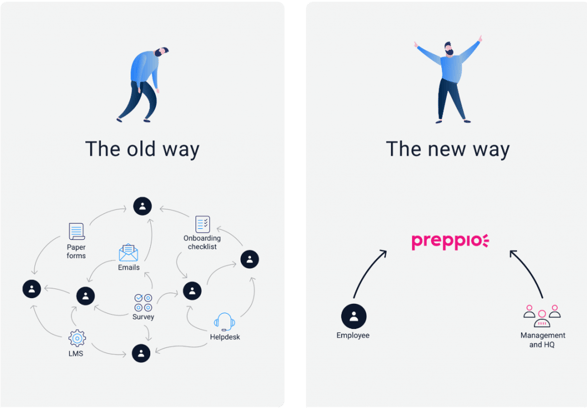
Need Help Building A Business Case?
If you need help building a business case for employee onboarding software, our team at Preppio can assist you.
We have extensive experience in the onboarding space and know what it takes to make a successful case for change.
Schedule a free consultation with one of our experts today.
Just click here.
Conclusion
Employee onboarding is a critical process for any business.
The right employee onboarding software can save your team time, money, and energy while optimizing the onboarding experience for your new hires.
But not everyone in your organization will have this top of mind the way you do.
You can BRING IT top of mind by outlining the business case for employee onboarding software in easy-to-understand terms.
If you need help building a business case for employee onboarding software, our team at Preppio can assist you.
Schedule a free consultation.
